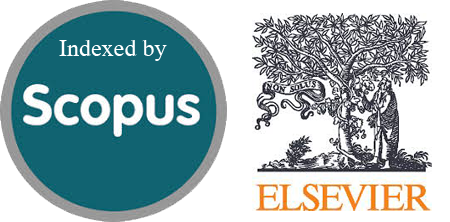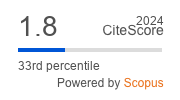ResNet101 Model Performance Enhancement in Classifying Rice Diseases with Leaf Images
Abstract
Indonesia is the fourth biggest rice producer in Asia with its production accounting for 35.4 million metric tons yearly. This figure can increase unless rice crop failure is resolved. Identifying rice diseases, however, may serve as an approach to minimizing the risk of crop failure. The classification to detect rice diseases was previously researched using ResNet101 method with 100% accuracy. Despite this perfect accuracy, this approach does not come without an issue, where the prediction is not yet optimal for each label and loss results which are regarded as too high due to overfitting. Departing from this issue, this research aims to improve the model by reducing the layer complexity of the model and comparing two layers structures of the model, two different data, and the ResNet101 model. The performance resulting from the model could be enhanced with the structuring of simple architectural layers. Despite the small quantity of dataset, the model performance can yield 100% accuracy in the classification of rice diseases with a loss value of 2.91%. The model performance in this research experienced a 2.7% increase at the loss value and it could accurately classify the type of rice diseases according to leaf images on each label. The problem solved by this research is that ResNet101 is able to classify rice disease accurately even with a small amount of data by utilizing the appropriate layer arrangement with data requirements. In addition, the overfitting that occurred in previous research can also be resolved properly. This matter proves that the correlation between the layers of the model with the amount of data is very influential.
Downloads
References
Klasifikasi Penyakit Tanaman Padi Menggunakan Model Deep Learning Efficientnet B3 dengan Transfer Learning,” J. Ilm. SINUS, vol. 19, no. 1, p. 75, 2021, doi: 10.30646/sinus.v19i1.526.
R. A. Saputra, S. Wasiyanti, A. Supriyatna, and D. F. Saefudin, “Penerapan Algoritma Convolutional Neural Network Dan Arsitektur MobileNet Pada Aplikasi Deteksi Penyakit Daun Padi,” Swabumi, vol. 9, no. 2, pp. 184–188, 2021, doi: 10.31294/swabumi.v9i2.11678.
M. Z. Alom et al., “A state-of-the-art survey on deep learning theory and architectures,” Electron., vol. 8, no. 3, 2019, doi: 10.3390/electronics8030292.
W. jie Liang, H. Zhang, G. feng Zhang, and H. xin Cao, “Rice Blast Disease Recognition Using a Deep Convolutional Neural Network,” Sci. Rep., vol. 9, no. 1, pp. 1–10, 2019, doi: 10.1038/s41598-019-38966-0.
C. R. Rahman et al., “Identification and recognition of rice diseases and pests using convolutional neural networks,” Biosyst. Eng., vol. 194, pp. 112–120, 2020, doi: 10.1016/j.biosystemseng.2020.03.020.
M. A. Islam, N. Rahman Shuvo, M. Shamsojjaman, S. Hasan, S. Hossain, and T. Khatun, “An Automated Convolutional Neural Network Based Approach for Paddy Leaf Disease Detection,” Int. J. Adv. Comput. Sci. Appl., vol. 12, no. 1, pp. 280–288, 2021, doi: 10.14569/IJACSA.2021.0120134.
J. Chen, J. Chen, D. Zhang, Y. Sun, and Y. A. Nanehkaran, “Using deep transfer learning for image-based plant disease identification,” Comput. Electron. Agric., vol. 173, no. November 2019, p. 105393, 2020, doi: 10.1016/j.compag.2020.105393.
K. S. Wibawa, P. Studi, T. Informasi, F. Teknik, U. Udayana, and B. Jimbaran, “Segmentasi Buah Apel Menggunakan Framework YOLACT Arsitektur Resnet-101,” vol. 1, no. 2, 2020.
Y. Ibrahim et al., “Soft Error Resilience of Deep Residual Networks for Object Recognition,” IEEE Access, vol. 8, pp. 19490–19503, 2020, doi: 10.1109/ACCESS.2020.2968129.
A. Ridhovan and A. Suharso, “Penerapan Metode Residual Network (Resnet) Dalam Klasifikasi Penyakit Pada Daun Gandum,” JIPI (Jurnal Ilm. Penelit. dan Pembelajaran Inform., vol. 7, no. 1, pp. 58–65, 2022, doi: 10.29100/jipi.v7i1.2410.
H. B. Prajapati, J. P. Shah, and V. K. Dabhi, “Detection and classification of rice plant diseases,” Intell. Decis. Technol., vol. 11, no. 3, pp. 357–373, 2017, doi: 10.3233/IDT-170301.
Ulfah Nur Oktaviana, Ricky Hendrawan, Alfian Dwi Khoirul Annas, and Galih Wasis Wicaksono, “Klasifikasi Penyakit Padi berdasarkan Citra Daun Menggunakan Model Terlatih Resnet101,” J. RESTI (Rekayasa Sist. dan Teknol. Informasi), vol. 5, no. 6, pp. 1216–1222, 2021, doi: 10.29207/resti.v5i6.3607.
R. F. Finazis and T. Soehartanto, “Pemodelan Polishing Unit Berbasis Jaringan Syaraf Tiruan di PT Saka Indonesia Pangkah Limited,” J. Tek. ITS, vol. 8, no. 2, pp. 194–199, 2020, doi: 10.12962/j23373539.v8i2.47237.
A. Septadaya, C. Dewi, and B. Rahayudi, “Implementasi Extreme Learning Machine dan Fast Independent Component Analysis untuk Klasifikasi Aritmia Berdasarkan Rekaman Elektrokardiogram,” vol. 3, no. 5, pp. 5007–5016, 2019.
I. Terapan, U. Telkom, T. Elektro, and U. Telkom, “Analisis Fitur Domain Waktu ECG Heart Rate Variability Berdasarkan Gain Informasi,” vol. 10, no. 2, 2022.
H. Hendriyana and Yazid Hilman Maulana, “Identification of Types of Wood using Convolutional Neural Network with Mobilenet Architecture,” J. RESTI (Rekayasa Sist. dan Teknol. Informasi), vol. 4, no. 1, pp. 70–76, 2020, doi: 10.29207/resti.v4i1.1445.
N. U. R. Ibrahim, S. S. A. Idah, B. Hidayat, and S. Darana, “Klasifikasi Grade Telur Ayam Negeri secara non- Invasive menggunakan Convolutional Neural Network,” vol. 10, no. 2, pp. 297–308, 2022.
K. Thenmozhi and U. Srinivasulu Reddy, “Crop pest classification based on deep convolutional neural network and transfer learning,” Comput. Electron. Agric., vol. 164, no. July, p. 104906, 2019, doi: 10.1016/j.compag.2019.104906.
M. Susanty, ; Raka, and S. Wardana, “PETIR: Jurnal Pengkajian dan Penerapan Teknik Informatika Prediksi Tekanan Pori Berdasarkan Data Logging Sumur Menggunakan Deep Neural Network,” vol. 14, no. 1, pp. 81–89, 2021, [Online]. Available: https://doi.org/10.33322/petir.v14i1.964.
R. Jain, P. Nagrath, G. Kataria, V. Sirish Kaushik, and D. Jude Hemanth, “Pneumonia detection in chest X-ray images using convolutional neural networks and transfer learning,” Meas. J. Int. Meas. Confed., vol. 165, p. 108046, 2020, doi: 10.1016/j.measurement.2020.108046.
A. Chakraborty, D. Kumer, and K. Deeba, “Plant Leaf Disease Recognition Using Fastai Image Classification,” Proc. - 5th Int. Conf. Comput. Methodol. Commun. ICCMC 2021, no. Iccmc, pp. 1624–1630, 2021, doi: 10.1109/ICCMC51019.2021.9418042.
L. W. Liu, S. H. Hsieh, S. J. Lin, Y. M. Wang, and W. S. Lin, “Rice blast (Magnaporthe oryzae) occurrence prediction and the key factor sensitivity analysis by machine learning,” Agronomy, vol. 11, no. 4, pp. 1–15, 2021, doi: 10.3390/agronomy11040771.
M. Koklu, I. Cinar, and Y. S. Taspinar, “Classification of rice varieties with deep learning methods,” Comput. Electron. Agric., vol. 187, no. November 2020, p. 106285, 2021, doi: 10.1016/j.compag.2021.106285.
S. Ramesh and D. Vydeki, “Application of machine learning in detection of blast disease in south indian rice crops,” J. Phytol., vol. 11, pp. 31–37, 2019, doi: 10.25081/jp.2019
Copyright (c) 2023 Jurnal RESTI (Rekayasa Sistem dan Teknologi Informasi)

This work is licensed under a Creative Commons Attribution 4.0 International License.
Copyright in each article belongs to the author
- The author acknowledges that the RESTI Journal (System Engineering and Information Technology) is the first publisher to publish with a license Creative Commons Attribution 4.0 International License.
- Authors can enter writing separately, arrange the non-exclusive distribution of manuscripts that have been published in this journal into other versions (eg sent to the author's institutional repository, publication in a book, etc.), by acknowledging that the manuscript has been published for the first time in the RESTI (Rekayasa Sistem dan Teknologi Informasi) journal ;








